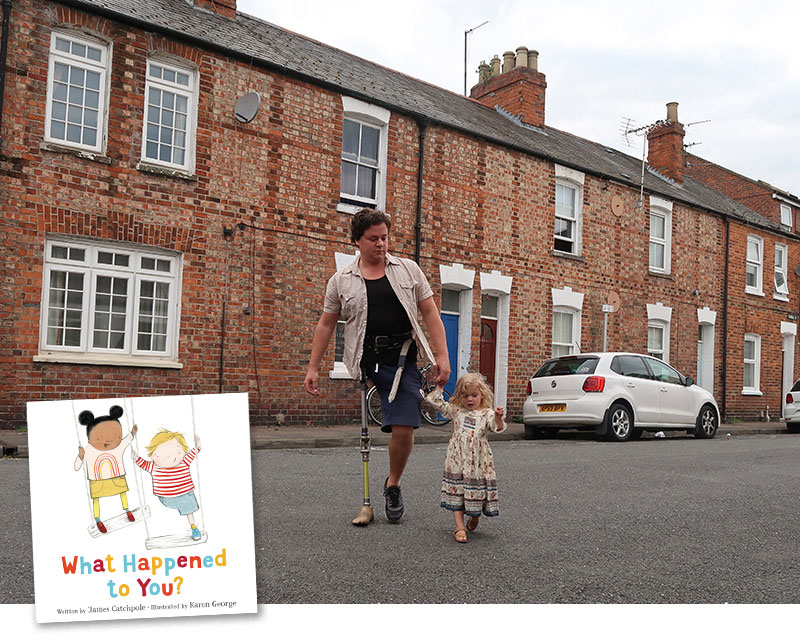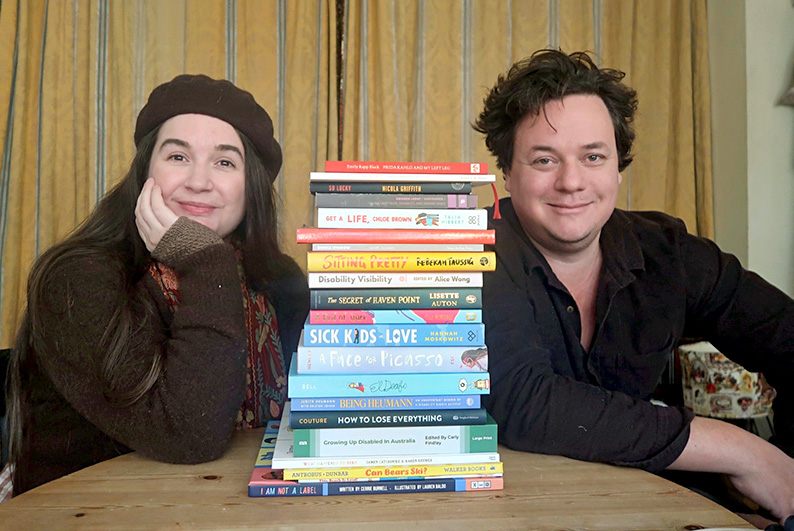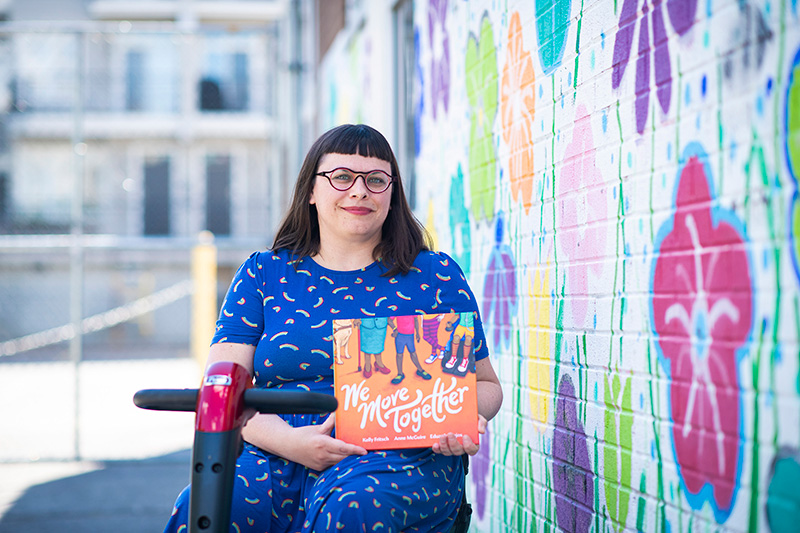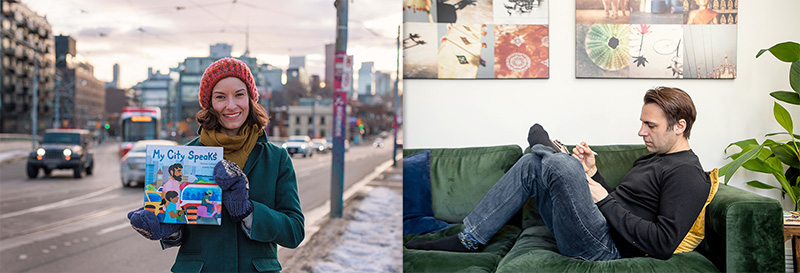Picture Book Creators Center Joy While Portraying Disability
Normalizing physical disability can and should begin in childhood. These creators are doing just that.

At the playground with his young children, U.K. author James Catchpole often finds himself fielding questions from kids about why he only has one leg. Catchpole responds much better to the question at 40 than he could at five, he says. But it still sends him back to his childhood and the awkwardness he felt when faced with that query again and again.
That experience prompted him to write What Happened to You?, about Joe, who only wants to play pirates and is fed up with people at the playground asking why he’s missing a leg.
His book complements the very small, but growing, number of illustrated books featuring characters with physical disabilities. More books portraying disabled characters have been published in the last few years than ever before. But while 26 percent of U.S. Americans have disabilities, in 2019, disabled main characters made appearances in just 3.4 percent of children’s picture books.
 |
Keah Brown |
Like all children, disabled kids need to see themselves in books—particularly in stories that move beyond inspiration and trauma narratives, like the bullied disabled child or the disabled child who “overcomes” their disability to achieve their goals.
Equally important is for nondisabled children to read disabled stories outside of ableist stereotypes—to see the beauty in all types of bodies and minds.
“[Disabled people] are allowed joy. We are allowed happiness,” says Keah Brown, author of Sam’s Super Seats, about a girl with cerebral palsy going back-to-school shopping with friends. “I really think [exposure to disability in picture books] opens up a whole world of possibility."
The Schneider Family Book Award recognizes excellence in portrayals of disability in children’s literature. For every qualifying picture book the committee received this year, it received three middle grade novels, says 2022 Schneider committee member Scot Smith, librarian at Robertsville Middle School in Oak Ridge, TN. That’s more than in previous years, when the committee often only received 10 to 15 qualifying picture books, according to Smith.
[Also read: Six Manga About People with Disabilities]
 |
Francesca Cavallo |
The quality of picture book disability representation has improved over the years, Smith says. But many disabled authors and illustrators I spoke with (and works I have seen as a disabled book reviewer) continue to portray disabled stereotypes and tokenism.
That is partly why Francesca Cavallo, coauthor of Good Night Stories for Rebel Girls, founded the venture Undercats in 2019. With the mission to “radically increasing diversity in children’s media,” Undercats addresses ableism by publishing a series of picture book biographies about paralympic athletes.
"[Most of us] are just temporarily able-bodied," says Cavallo. "We break legs, we grow old, we have accidents. Our bodies change. But we want to live life as if disability didn't exist, and that is the problem at the core of ableism."
"The problem with books about underrepresented categories of people is that very often authors or publishers believe that their ‘good intention’ is enough to create a good book,” Cavallo adds. “Well, it very much isn't. We all grew up in an extremely ableist society, and we can't get over our ableism if we are not willing to look at it and challenge it with brutal honesty."
 |
Lucy and James Catchpole |
Catchpole is also a literary agent, and he and his wife, Lucy Catchpole, have compiled a helpful list of common disability stereotypes in children's books on their Instagram account. Those range from "failure to centre the disabled character, to playing their disability for laughs, to cataloguing them by diagnosis, to making them into an educational resource for nondisabled readers." The Catchpoles also provide tips for illustrators when depicting disability.
 The popular picture book about disability and being different Just Ask! Be Different, Be Brave, Be You by Supreme Court Associate Justice Sonia Sotomayor prompts children to ask others why they’re the way they are. But this question can often be uncomfortable or even traumatic for disabled people.
The popular picture book about disability and being different Just Ask! Be Different, Be Brave, Be You by Supreme Court Associate Justice Sonia Sotomayor prompts children to ask others why they’re the way they are. But this question can often be uncomfortable or even traumatic for disabled people.
Though children mean no harm by such questions, being asked, “What’s wrong with you?” is a form of ableism, advocates say. No one has a right to another person’s medical history. Catchpole’s What Happened to You? shows kids how awkward and uncomfortable that question can be and calls on children to play with one another instead. The book also includes a helpful guide for parents about how to respond when their children ask a disabled person intrusive questions.
Brown felt called to write Sam’s Super Seats due to a lack of representation. “Growing up in the ‘90s, I didn’t really see books with disabled people in general, let alone a little disabled Black girl who has friends who love her, parents who love her,” says Brown, also creator of the hashtag #DisabledAndCute and author of The Pretty One: On Life, Pop Culture, Disability, and Other Reasons to Fall in Love with Me. “She has dreams and hopes and ideas. I wrote the book I would have loved to see as a child. I want young kids to understand who they are, every way they are, is valuable. It’s enough....Your stories matter.”
Portraying joy
It was important for Brown that her story center joy, not a trauma narrative.
“Don’t look at me as your worst-case scenario,” she says. “I’m my best-case scenario, and I hope we can get to a place in my lifetime where we’re not looking at disability as a thing to be ashamed of.”
Handled well, books can show the vastness of the disabled experience and the many possibilities for humor and happiness.
 |
Kelly Fritsch |
Disability justice scholar Kelly Fritsch and coauthor Anne McGuire felt the need to write We Move Together because they had read too many problematic portrayals of disability and had trouble finding books that centered disability justice.
“Most books we encountered did not include diverse disabled characters or engage with disability as a social justice issue,” Fritsch says. “Seldom did [they] depict disability or assistive devices with accuracy, let alone as an aesthetic expression. The books we found were more about how sad or tragic disability is, depicting disability solely as a medical issue, or as a problem experienced by one individual.”
Like Brown’s picture book, We Move Together centers joy in tandem with the disability experience. It depicts a variety of disabled children and adults convening and moving joyfully in accessible spaces.
Accuracy issues
While wheelchair users are the most common go-to disability shown in picture books, the depictions often lack accessibility consideration or are problematic in other ways. An illustration will show a child in a wheelchair at the bottom of a staircase or rolling uphill through grass, for example.
Other times, wheelchair users are in the background of a setting that lacks accessibility considerations. Or a main character's story is framed in a problematic way, as in a recent, award-winning release, I See You See, which confusingly compares a child in a wheelchair to a dog: “Mom calls, ‘Maisie, walk the dog, will you?’/ ‘Me too,’ Jonah says to his sister. ‘Walk me.’" Or picture books begin with a sad parent wishing their child wasn't disabled.
 |
Ali Stroker |
Ali Stroker, the Tony Award–winning singer, actor, and author of the picture book Ali and the Sea Stars, says it was vitally important for her to write a main character in a wheelchair, like she is, and to create a story that “wasn’t about her being in a wheelchair.” The book shows how a young Ali put on a musical at the beach.
Best Day Ever! by Marilyn Singer and disabled illustrator Leah Nixon also includes a positive, accurate portrayal of a young wheelchair user. Nixon says it was the editor’s idea to have the main character be a wheelchair user. The editor wanted an illustrator who also used a wheelchair to make the book as authentic as possible and looked at several people’s work before deciding on Nixon’s.
While Nixon based Best Day Ever! on her own experiences using a wheelchair and playing with her dog, she also reached out to families with children in wheelchairs to ensure her portrayal was accurate, since adult chairs are built differently.
 |
Leah Nixon |
“I tried to purposely challenge what it means to be a kid in a wheelchair,” Nixon says. “In one illustration, the kid is in a sandbox. Kids can move outside their wheelchair, but a lot of nondisabled people have the idea of people always being stuck in their wheelchairs.”
Often, the best way to combat tokenism and problematic portrayals is to hire disabled creators, like Nixon’s editors did. This isn’t to say that good picture books with disabled characters written and illustrated by nondisabled creators don’t exist. They do, though it requires more work.
Darren Lebeuf and Ashley Barron teamed up on three picture books about children noticing little things in their surroundings that other people miss, two of which contain disabled characters: My Ocean Is Blue and My City Speaks, which won the 2022 Schneider Award. In both cases, the publisher decided to center disabled characters.
 |
Ashley Barron and Darren Lebeuf |
The editors let Barron choose what kind of disability to portray in My Ocean is Blue. In her research, Barron happened upon a blog by a mom that included photographs of her daughter, who has cerebral palsy and uses crutches, at the beach, and drew on that for inspiration. For My City Speaks, the publisher asked Lebeuf and Barron to include a visually impaired main character. This did not really change Lebeuf’s approach to writing, but it required a massive amount of research from Barron. “It was worth the extra work,” Barron says. “You learn by doing books.”
Nondisabled creators can also ensure accuracy by hiring disabled people to critique the work. I asked children’s book writers and illustrators from the KidLit 411 group how they and their publishers approach portraying marginalized identities in picture books when they are not members of that identity. The universal response echoed the importance of hiring sensitivity/expert readers. Creators should include provisions in their contract concerning hiring these readers, they advised, and insist on reviewing final copies to ensure non-offensive portrayals. Having a sensitivity reader look at initial sketches is also ideal, so there is adequate time to revise art.
While creators want to see more representation of physical disability in picture books, many added that no representation is better than poor representation.
“If you can’t craft a book where a disabled person is seen as a fully realized human being...you shouldn’t be writing picture books,” Brown says.
“[T]he industry needs to find disabled creators to write and illustrate books,” Catchpole maintains. “The first step might well be to clear the space for those voices by refusing to publish any more bad representations of disability by nondisabled authors.”
And there’s the call for joy. “We need representations that celebrate and relish in the joy of disabled bodies, minds, and movements,” Fritsch says. That includes “our contributions, our innovations, our cultural and artistic practices, and our communities!”
Eight titles to consider
|
Margaret Kingsbury is a freelance writer, editor, website assistant, and all-around book nerd based in Nashville, TN. She reviews books regularly for Book Riot and BuzzFeed Books, and her other pieces on books and disability have appeared in StarTrek.com, Parents, The Lily, Earth Island Journal, and other venues. Follow her on Instagram @BabyLibrarians and Twitter @AReaderlyMom.
RELATED
The job outlook in 2030: Librarians will be in demand
The job outlook in 2030: Librarians will be in demand
ALREADY A SUBSCRIBER? LOG IN
We are currently offering this content for free. Sign up now to activate your personal profile, where you can save articles for future viewing






Add Comment :-
Be the first reader to comment.
Comment Policy:
Comment should not be empty !!!